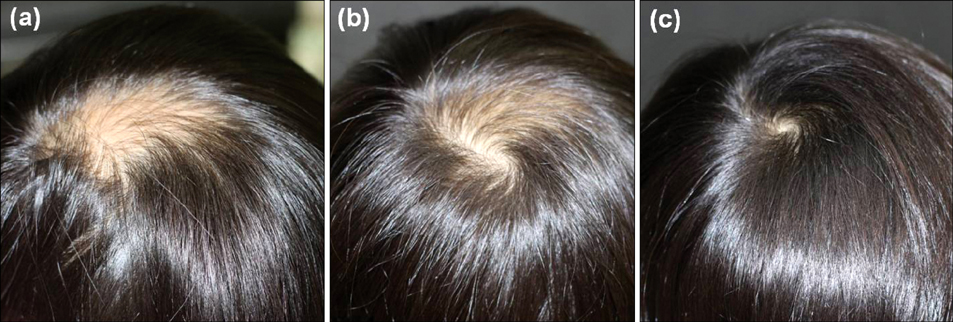Ann Dermatol.
2012 Aug;24(3):341-344. 10.5021/ad.2012.24.3.341.
Successful Treatment of Alopecia Areata with Topical Calcipotriol
- Affiliations
-
- 1Department of Dermatology, Chung-Ang University College of Medicine, Seoul, Korea. beomjoon@unitel.co.kr
- KMID: 2265308
- DOI: http://doi.org/10.5021/ad.2012.24.3.341
Abstract
- Alopecia areata (AA) is an inflammatory hair loss of unknown etiology. AA is chronic and relapsing, and no effective cure or preventive treatment has been established. Vitamin D was recently reported to be important in cutaneous immune modulation as well as calcium regulation and bone metabolism. It is well known that areata is common clinical finding in patients with vitamin D deficiency, vitamin D-resistant rickets, or vitamin D receptor (VDR) mutation. The biological actions of vitamin D3 derivatives include regulation of epidermal cell proliferation and differentiation and modulation of cytokine production. These effects might explain the efficacy of vitamin D3 derivatives for treating AA. In this study, we report a 7-year-old boy with reduced VDR expression in AA, recovery of whom was observed by topical application of calcipotriol, a strong vitamin D analog.
Keyword
MeSH Terms
Figure
Reference
-
1. Reichrath J, Schilli M, Kerber A, Bahmer FA, Czarnetzki BM, Paus R. Hair follicle expression of 1,25-dihydroxyvitamin D3 receptors during the murine hair cycle. Br J Dermatol. 1994. 131:477–482.
Article2. Reichel H, Koeffler HP, Norman AW. The role of the vitamin D endocrine system in health and disease. N Engl J Med. 1989. 320:980–991.
Article3. Xie Z, Komuves L, Yu QC, Elalieh H, Ng DC, Leary C, et al. Lack of the vitamin D receptor is associated with reduced epidermal differentiation and hair follicle growth. J Invest Dermatol. 2002. 118:11–16.
Article4. Sakai Y, Kishimoto J, Demay MB. Metabolic and cellular analysis of alopecia in vitamin D receptor knockout mice. J Clin Invest. 2001. 107:961–966.
Article5. Forghani N, Lum C, Krishnan S, Wang J, Wilson DM, Blackett PR, et al. Two new unrelated cases of hereditary 1,25-dihydroxyvitamin D-resistant rickets with alopecia resulting from the same novel nonsense mutation in the vitamin D receptor gene. J Pediatr Endocrinol Metab. 2010. 23:843–850.
Article6. MacDonald Hull SP, Wood ML, Hutchinson PE, Sladden M, Messenger AG. British Association of Dermatologists. Guidelines for the management of alopecia areata. Br J Dermatol. 2003. 149:692–699.
Article7. Nancy AL, Yehuda S. Prediction and prevention of autoimmune skin disorders. Arch Dermatol Res. 2009. 301:57–64.
Article8. Alkhalifah A, Alsantali A, Wang E, McElwee KJ, Shapiro J. Alopecia areata update: part II. Treatment. J Am Acad Dermatol. 2010. 62:191–202.9. Arnson Y, Amital H, Shoenfeld Y. Vitamin D and autoimmunity: new aetiological and therapeutic considerations. Ann Rheum Dis. 2007. 66:1137–1142.
Article10. Boonstra A, Barrat FJ, Crain C, Heath VL, Savelkoul HF, O'Garra A. 1alpha,25-Dihydroxyvitamin d3 has a direct effect on naive CD4(+) T cells to enhance the development of Th2 cells. J Immunol. 2001. 167:4974–4980.
Article11. van Etten E, Mathieu C. Immunoregulation by 1,25-dihydroxyvitamin D3: basic concepts. J Steroid Biochem Mol Biol. 2005. 97:93–101.
Article12. Linker-Israeli M, Elstner E, Klinenberg JR, Wallace DJ, Koeffler HP. Vitamin D(3) and its synthetic analogs inhibit the spontaneous in vitro immunoglobulin production by SLE-derived PBMC. Clin Immunol. 2001. 99:82–93.
Article13. Griffin MD, Lutz W, Phan VA, Bachman LA, McKean DJ, Kumar R. Dendritic cell modulation by 1alpha,25 dihydroxyvitamin D3 and its analogs: a vitamin D receptor-dependent pathway that promotes a persistent state of immaturity in vitro and in vivo. Proc Natl Acad Sci U S A. 2001. 98:6800–6805.
Article14. D'Ambrosio D, Cippitelli M, Cocciolo MG, Mazzeo D, Di Lucia P, Lang R, et al. Inhibition of IL-12 production by 1,25-dihydroxyvitamin D3. Involvement of NF-kappaB downregulation in transcriptional repression of the p40 gene. J Clin Invest. 1998. 101:252–262.15. Segaert S, Simonart T. The epidermal vitamin D system and innate immunity: some more light shed on this unique photoendocrine system? Dermatology. 2008. 217:7–11.
Article16. Zehnder D, Bland R, Williams MC, McNinch RW, Howie AJ, Stewart PM, et al. Extrarenal expression of 25-hydroxyvitamin d(3)-1 alpha-hydroxylase. J Clin Endocrinol Metab. 2001. 86:888–894.



